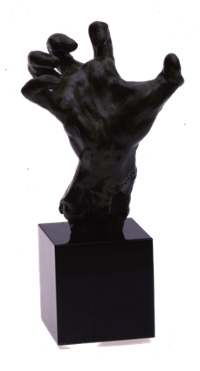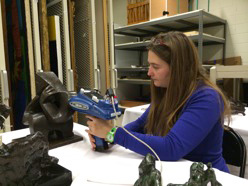Bread Crumbs in Bronze: Connecting Chemistry and Art History in Rodin's Sculptures
Widely considered the father of modern sculpture, the French artist Auguste Rodin created some of the most memorable works known to humanity, including The Thinker. But dating the vast number of bronze sculptures created by the prolific artist poses a challenge for museums worldwide. Now, scientists at the Northwestern University/Art Institute of Chicago Center for Scientific Studies in the Arts (NU-ACCESS) have developed a method to help museums — by examining the very material that make up these art works.
In the19th and early 20th Centuries, artists such as Rodin worked closely with metal-casting workshops known as foundries in creating their sculptures, said Monica Ganio, a postdoctoral fellow at NU-ACCESS who worked on the project. An artist such as Rodin would build a clay model of his sculpture and send it to foundries in Paris, where artisans would cast the actual sculptures in bronze.
It’s common practice for foundries to create several editions of bronze sculptures based on the artist’s original. But Rodin’s sculptures were a special case, Ganio said, because just before his death, the artist gave the French government the right to make as many replicas of his sculptures as it wanted. These casts include a massive collection at the Cantor Arts Center at Stanford University, comprising 200 sculptures.
By examining the chemical composition of bronze, scientists at NU-ACCESS identified the foundries that cast Rodin’s The Mighty Hand and other famous sculptures collected at the Smart Museum at the University of Chicago. (Credit: The Smart Museum at the University of Chicago)
Though these posthumous replicas are considered authentic Rodin sculptures, it is often thought that the earlier the sculptures were cast, the more they preserved the artist’s fine markings, said Francesca Casadio, co-director at NU-ACCESS. Yet historians have little archival information on the earlier casts, which impeded efforts to identify and date some of them.
So a team of scientists led by Marc Walton, a material science professor at Northwestern University and senior scientist at NU-ACCESS, decided to look elsewhere — at the bronze that makes up the sculptures. A metal alloy used for vessels and sculptures since ancient Greece, bronze consists primarily of copper and tin, but foundries during Rodin’s time also added zinc to the alloy to lower its melting point, resulting in a more fluid material that can preserve finer details in the artist’s original sculpture, Ganio said.
As in any competing business, the foundries each had a unique bronze recipe, a trade secret that they guarded tightly, Casadio said. Too little zinc would result in a stiff material that loses the finer details, while too much of the element would produce sculptures that are too fragile. By altering the composition of the bronze as well as its surface finish, foundries could create different looks on the finished sculpture that catered to an artist’s taste, from polished and glossy, to matte.
“It’s a little bit like your favorite recipe for brownies,” Casadio said. “Yes it’s all flour and butter and chocolate and sugar, but if I make it and your grandma makes it, you may like your grandma’s better.”
That gave the scientists an idea: perhaps, by analyzing the exact chemical composition of Rodin’s bronze sculptures, they could find clues about which foundries produced which sculptures, and use the results to date the artworks.
To test their idea, the scientists examined 23 sculptures at the Smart Museum at the University of Chicago, consisting of works made not just by Rodin, but also by contemporaries such as Jacques Lipchitz. About three quarters of the sculptures had clear trails of ownership that showed which foundries cast them, while the provenance of the other sculptures were unknown, Ganio said.
To analyze the chemical composition of these sculptures without damage to them, scientists employed a special tool: a handheld, non-invasive X-ray machine, known as the X-Ray Florescence Spectrometer.For each sculpture, they used the machine to shine X-rays at various spots on the sculptures from a distance. The X-rays excite electrons in the bronze, which emit back florescent light.From the florescent signatures, which serve as barcodes for different elements in the bronze, the scientists determinedthe exact chemical composition of thesculptures—without so much as touching the sculptures. Once they knew the chemical compositions of each sculpture, the scientists performed statistical analysis on the sculptures with known provenance to see if their hypothesis was right. And indeed, sculptures from the same foundry clustered together in a distinct group. For example, bronze produced by the foundry Alexis Rudier, which cast a majority of Rodin’s sculptures, had very low zinc content, a fact that might have had to do with a specific metal-casting technique the foundry used, Ganio said.
Like true detectives, the scientists used the data to deduce the unknown from what they now knew. They established a database of the bronze recipes associated with each foundry, and examined the chemical composition of the sculptures with unknown provenance to see where they might have been cast.
And that’s just the beginning of their detective work. At the end of this month, the NU-ACCESS scientists are flying west to the Cantor Art Center at Stanford, where they will examine the museum’s collection of Rodin sculptures, and add these specific material clues to the toolkit that art historians can use to identify the foundries that produced them.
Come September, the scientists are hoping to collaborate with the Picasso Museum in Paris and the Museum of Modern Art in New York, which is opening a major retrospective of Pablo Picasso’s sculptures. The scientists will perform the same chemical analysis on the Picasso artworks, and they have a lot of questions to answer, Casadio said: Did Picasso work with the same foundries that Rodin worked with? And if he did, did the foundries change their recipes over time?
“It’s opening up very interesting new paths for art history,” Casadio said. “Now the scientific information is coming at the same level of connoisseurship. Defining the composition of an alloy becomes as valuable as finding an unknown document in the archive in terms of telling the history of art, which, in a sense, also tells us about our place in the world.”
